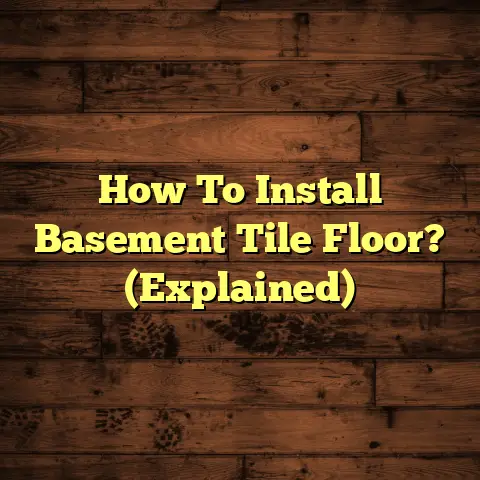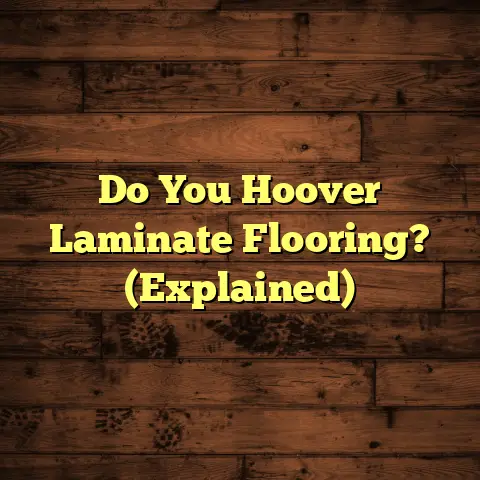Burnt Wood Floor: Repair It? (2 Pro Secrets!)
Wood floors are the heart of many homes, adding warmth and character. But let’s face it, life happens. A momentary lapse in concentration, a rogue ember from the fireplace, and BAM! You’ve got a burn mark staring back at you.
Don’t panic! I’m here to tell you that burnt wood floors aren’t always a lost cause. In fact, I’m going to share a quick win that can often restore minor damage, and then dive into two pro secrets that can tackle even more significant burns.
Quick Win Alert: Before we get started, let’s talk about a super simple fix for minor burns! You can often lighten or even eliminate small scorch marks with a paste of baking soda and vinegar. Seriously! Mix it up, gently rub it on the affected area, let it sit for a bit, and wipe it away. You might be surprised at the results!
This article is your guide to understanding, repairing, and preventing burnt wood floor damage. Let’s get started!
Section 1: Understanding Burnt Wood Floors
What exactly is a burnt wood floor? It’s any wood floor that has sustained damage from excessive heat, resulting in charring, discoloration, or structural changes to the wood.
The severity of the burn can vary greatly. We’re talking everything from a light surface scorch to a deep, penetrating burn that affects multiple layers of the wood. I usually categorize burn levels like this:
-
Surface Scorch: This is the best-case scenario. It’s usually just a discoloration on the surface of the finish, often caused by a hot pan or spilled candle wax.
-
Medium Burn: This penetrates a bit deeper, affecting the wood itself. You’ll likely see charring and a noticeable indentation.
-
Deep Burn: This is the worst. The burn goes deep into the wood, potentially weakening its structure. It might even create a hole.
What Kind of Wood Are We Talking About?
The type of wood flooring you have plays a big role in how it reacts to heat. Here’s a quick rundown of common materials:
-
Solid Hardwood: This is the real deal – planks made from a single piece of wood. Oak, maple, and hickory are popular choices.
-
Engineered Hardwood: This has a thin layer of hardwood veneer on top of a plywood or fiberboard core.
-
Laminate: This is a synthetic material that mimics the look of wood. It’s typically more resistant to heat than real wood, but it can still be damaged.
Each material reacts differently to heat. Solid hardwood can often withstand more aggressive repairs like sanding, while engineered hardwood has a thinner wear layer, requiring a more delicate approach. Laminate, if deeply burned, might be beyond repair.
Burn Scenarios: How Does This Even Happen?
I’ve seen it all when it comes to how wood floors get burned. Some of the most common culprits include:
- Kitchen Mishaps: Hot pots and pans, spilled grease, and runaway cooking fires.
- Fireplace Accidents: Stray embers popping out of the fireplace.
- Candles & Heaters: Leaving candles or space heaters too close to the floor.
- DIY Disasters: Welding or soldering projects gone wrong.
I remember one client who was trying to strip paint off a piece of furniture using a heat gun. He accidentally rested the heat gun on the floor for a few seconds, leaving a nasty burn mark. A little carelessness can cause a lot of damage!
Why is Burn Damage a Big Deal?
Beyond the obvious aesthetic issues, burn damage can affect the structural integrity of your wood floor. A deep burn weakens the wood fibers, making the floor more susceptible to cracking, splintering, or even collapsing under heavy weight.
Furthermore, burn damage can create a fire hazard. Charred wood is more flammable than unburned wood, increasing the risk of a fire spreading quickly.
Section 2: Quick Win – The Simple Fix
Alright, let’s get to that quick win I promised you! This method is best for surface scorches or very minor burns. It won’t work miracles on deep burns, but it’s worth a shot before you resort to more drastic measures.
What You’ll Need:
- White Vinegar: Acts as a mild cleaning agent.
- Baking Soda: A gentle abrasive.
- Soft Cloth or Sponge: For applying and wiping.
- Wood Stain (Optional): To touch up the color, if needed.
- Furniture Polish (Optional): To restore shine.
Step-by-Step Instructions:
- Clean the Area: Start by wiping the burnt area with a damp cloth to remove any loose debris.
- Make a Paste: Mix equal parts white vinegar and baking soda to form a thick paste.
- Apply the Paste: Gently apply the paste to the burnt area, making sure to cover it completely.
- Let It Sit: Allow the paste to sit for 15-30 minutes. This gives the vinegar and baking soda time to work their magic.
- Scrub Gently: Use a soft cloth or sponge to gently scrub the area in a circular motion. Avoid using too much pressure, as you don’t want to damage the surrounding finish.
- Wipe Clean: Wipe away the paste with a damp cloth.
- Dry the Area: Dry the area thoroughly with a clean cloth.
- Assess the Results: Check to see if the scorch mark has lightened or disappeared. If it’s still visible, you can repeat the process or move on to the next step.
- Touch Up (Optional): If the color is slightly off, use a wood stain that closely matches your floor’s finish. Apply the stain sparingly and blend it carefully.
- Polish (Optional): Once the stain is dry, apply a furniture polish to restore shine and protect the finish.
Blending the Repair: The Art of Color Matching
One of the biggest challenges with this quick fix is blending the repaired area with the existing wood floor color. Here are a few tips:
- Test the Stain: Always test the stain on an inconspicuous area of the floor before applying it to the repaired area.
- Apply in Thin Layers: Apply the stain in thin layers, allowing each layer to dry before applying the next. This will help you achieve a more even color.
- Blend the Edges: Use a soft cloth to blend the edges of the stained area into the surrounding finish.
Limitations of the Quick Fix
This method is effective for minor surface scorches, but it won’t work on deeper burns that have penetrated the wood. Also, it might not be effective on floors with a very dark or complex finish.
Section 3: Pro Secret #1 – The Sanding Technique
Okay, so the quick fix didn’t quite cut it? Don’t worry, we’re moving on to the first pro secret: sanding. This technique is effective for removing more significant burn damage, but it requires a bit more skill and effort.
Assessing the Damage: Is Sanding Right for You?
Before you start sanding, it’s crucial to assess the damage and determine if sanding is the right approach. Ask yourself these questions:
- How Deep is the Burn? If the burn is only on the surface, sanding is a good option. However, if the burn has penetrated deep into the wood, you might need to use the wood filler method (which we’ll cover in the next section).
- What Type of Flooring Do You Have? Solid hardwood can withstand more aggressive sanding than engineered hardwood. If you have engineered hardwood, be careful not to sand through the veneer layer.
- Are You Comfortable with Power Tools? Sanding requires using a power sander, so you should be comfortable operating one safely.
If you’re unsure whether sanding is the right approach, it’s always best to consult with a professional flooring contractor.
Tools and Materials You’ll Need:
- Orbital Sander: For removing the burnt wood.
- Sandpaper (Various Grits): Start with a coarse grit (e.g., 60-grit) to remove the burn, then gradually move to finer grits (e.g., 80-grit, 120-grit, 180-grit) to smooth the surface.
- Sanding Block: For sanding edges and corners.
- Vacuum Cleaner: To remove dust.
- Tack Cloth: To remove any remaining dust.
- Wood Stain: To match the existing floor color.
- Polyurethane or Other Finish: To protect the wood.
- Safety Glasses: To protect your eyes.
- Dust Mask: To protect your lungs.
- Gloves: To protect your hands.
Step-by-Step Sanding Instructions:
- Prepare the Area: Clear the area around the burn and cover any nearby furniture with plastic sheeting.
- Start with Coarse Grit: Attach a 60-grit sandpaper to your orbital sander.
- Sand the Burnt Area: Gently sand the burnt area, using a circular motion. Avoid applying too much pressure, as you don’t want to create dips or gouges in the floor.
- Gradually Increase Grit: As you remove the burnt wood, gradually increase the grit of the sandpaper. Use 80-grit, then 120-grit, and finally 180-grit.
- Sand the Edges: Use a sanding block to sand the edges and corners of the repaired area.
- Vacuum Thoroughly: Vacuum the entire area to remove all dust.
- Wipe with Tack Cloth: Wipe the area with a tack cloth to remove any remaining dust.
- Stain the Wood: Apply a wood stain that closely matches your floor’s finish. Apply the stain sparingly and blend it carefully.
- Apply Finish: Once the stain is dry, apply a polyurethane or other finish to protect the wood. Follow the manufacturer’s instructions.
- Allow to Dry: Allow the finish to dry completely before walking on the floor.
Finishing Touches: Staining and Sealing
After sanding, you’ll need to stain and seal the repaired area to match the rest of your floor and protect the wood. Here are some tips:
- Matching the Stain: Take a sample of your existing floor to a paint store to find a stain that matches.
- Applying the Stain: Apply the stain evenly, using a brush or cloth. Wipe off any excess stain.
- Applying the Sealant: Apply several coats of sealant, allowing each coat to dry completely before applying the next.
Potential Pitfalls and How to Avoid Them
Sanding can be tricky, and it’s easy to make mistakes. Here are some common pitfalls and how to avoid them:
- Sanding Too Deep: Be careful not to sand through the veneer layer of engineered hardwood.
- Creating Dips and Gouges: Avoid applying too much pressure when sanding.
- Not Removing Enough Dust: Make sure to vacuum and wipe the area thoroughly before staining and sealing.
- Using the Wrong Stain: Test the stain on an inconspicuous area of the floor before applying it to the repaired area.
Section 4: Pro Secret #2 – The Wood Filler Method
Alright, let’s talk about the second pro secret: using wood filler. This is my go-to method for repairing deep burns that have penetrated the wood.
Wood Filler 101: Choosing the Right Type
Wood filler comes in different forms, and choosing the right one is crucial for a successful repair.
- Standard Wood Filler: This is a general-purpose filler that’s suitable for most repairs. It’s typically paintable and stainable, but it might not match the color of your wood perfectly.
- Colored Wood Filler: This type of filler is pre-tinted to match specific wood species. It’s a good option if you want to avoid staining the filler after it’s dry.
- Epoxy Wood Filler: This is a two-part filler that’s incredibly strong and durable. It’s a good choice for repairing large or structural damage.
I usually recommend using a colored wood filler that closely matches your floor’s color. It saves you the hassle of staining and provides a more seamless finish.
Materials Required:
- Wood Filler: Choose the appropriate type based on the severity of the burn and the type of wood.
- Putty Knife: For applying the filler.
- Sandpaper (Various Grits): For smoothing the filler.
- Vacuum Cleaner: To remove dust.
- Tack Cloth: To remove any remaining dust.
- Wood Stain (Optional): To touch up the color, if needed.
- Polyurethane or Other Finish: To protect the wood.
Step-by-Step Instructions:
- Clean the Area: Remove any loose debris from the burnt area.
- Apply the Filler: Use a putty knife to apply the wood filler to the burnt area. Overfill the area slightly, as the filler will shrink as it dries.
- Allow to Dry: Allow the filler to dry completely. This may take several hours or even overnight, depending on the type of filler.
- Sand the Filler: Once the filler is dry, sand it smooth with sandpaper. Start with a coarse grit (e.g., 120-grit) and gradually move to finer grits (e.g., 180-grit, 220-grit).
- Vacuum Thoroughly: Vacuum the entire area to remove all dust.
- Wipe with Tack Cloth: Wipe the area with a tack cloth to remove any remaining dust.
- Stain (Optional): If the filler doesn’t match the color of your floor, you can stain it.
- Apply Finish: Apply a polyurethane or other finish to protect the wood. Follow the manufacturer’s instructions.
- Allow to Dry: Allow the finish to dry completely before walking on the floor.
Matching Color and Texture: The Key to a Seamless Repair
The biggest challenge with using wood filler is matching the color and texture of the filler to the surrounding wood. Here are some tips:
- Choose the Right Filler: As I mentioned earlier, using a colored wood filler that closely matches your floor’s color is the easiest way to achieve a seamless repair.
- Mix Colors: If you can’t find a filler that matches perfectly, you can mix different colors of filler together to create a custom blend.
- Grain Matching: For a truly seamless repair, you can try to match the grain of the wood. Use a small tool to create artificial grain lines in the filler before it dries.
Sanding and Sealing: The Final Polish
After applying the filler, sanding, and staining (if necessary), you’ll need to seal the repaired area to protect it and blend it with the rest of your floor. Here are some tips:
- Apply Multiple Coats: Apply several thin coats of sealant, allowing each coat to dry completely before applying the next.
- Sand Between Coats: Lightly sand between coats of sealant to create a smooth, even finish.
- Use the Right Sealant: Choose a sealant that’s compatible with your floor’s existing finish.
Section 5: Preventive Measures and Maintenance Tips
Okay, you’ve repaired your burnt wood floor. Now, let’s talk about how to prevent future damage! Prevention is always better (and cheaper!) than repair.
Preventing Future Burn Damage
Here are some simple steps you can take to protect your wood floors from burns:
- Use Coasters and Trivets: Always use coasters under drinks and trivets under hot dishes.
- Use Area Rugs: Place area rugs in high-risk areas, such as near the fireplace or in the kitchen.
- Be Careful with Candles: Never leave candles unattended, and keep them away from flammable materials.
- Position Space Heaters Safely: Keep space heaters away from the floor and make sure they’re on a stable surface.
- Be Mindful of DIY Projects: If you’re working on a DIY project that involves heat, protect your floors with a drop cloth.
Wood Floor Maintenance: Keeping Them Pristine
Regular maintenance is essential for keeping your wood floors looking their best and preventing damage. Here are some tips:
- Sweep or Vacuum Regularly: Sweep or vacuum your floors regularly to remove dirt and debris.
- Mop with a Damp Cloth: Mop your floors with a damp cloth and a mild wood floor cleaner. Avoid using excessive water, as it can damage the wood.
- Avoid Harsh Chemicals: Don’t use harsh chemicals or abrasive cleaners on your wood floors.
- Refinish as Needed: Depending on the amount of traffic your floors receive, you may need to refinish them every few years.
I always tell my clients to be proactive about floor care. A little bit of prevention goes a long way in saving you from costly repairs down the line.
Conclusion
So, there you have it! Everything you need to know about repairing burnt wood floors. We covered a quick win for minor scorches, and then delved into two pro secrets: sanding and using wood filler.
Remember, burnt wood floors aren’t always a disaster. With the right techniques and materials, you can often restore your floors to their former glory.
Whether you decide to try the quick win method or invest time in the more involved pro secrets, I encourage you to take action. There’s nothing quite like the satisfaction of restoring your wood floors and maintaining the beauty of your home.
Good luck with your repairs, and remember, I’m always here if you need a hand!





